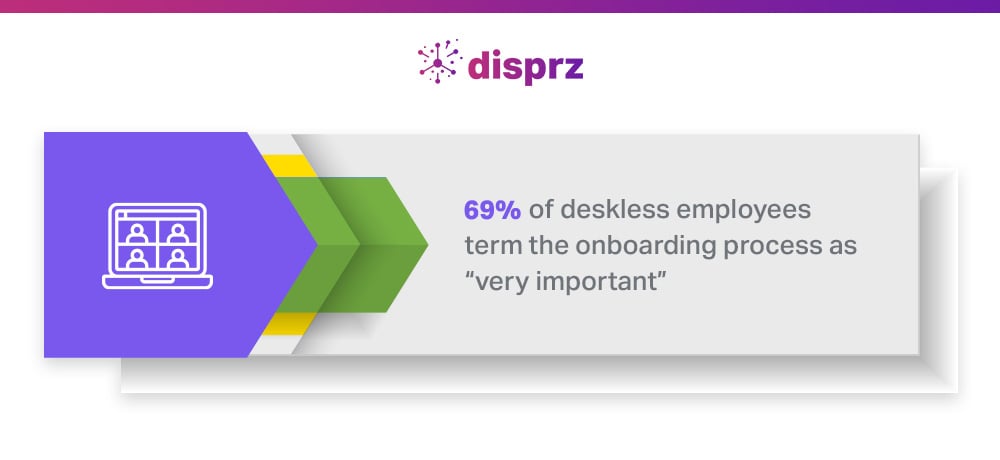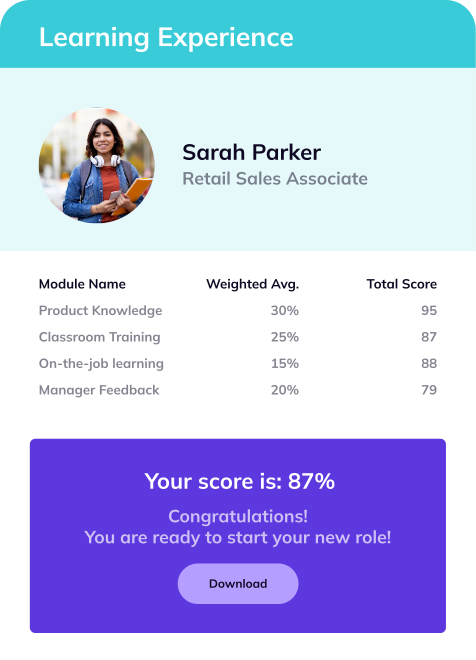Frontline workers are the heart of many businesses. They constitute almost 80% of the global workforce. Without them, business operations might just come to a halt.
Despite being a valuable resource of the company, the frontline workforce is the ones who hardly get the training they require to perform efficiently. Most companies focus on the knowledge workers and pay little or no attention to the frontline workforce. In fact, a survey of 1000 frontline employees found that 40% received training only once a year.
The frontline’s performance can directly impact the satisfaction level of a customer. Therefore, they need real-time learning opportunities to develop vital skills to improve workforce performance and provide the utmost customer satisfaction.
Challenges Faced by the Frontline Workforce in 2025
Understanding the challenges faced by frontline employees is essential to foster a supportive work environment. It also helps improve the overall organizational performance.
Here are some of the major challenges faced by the frontline
-
Customer interactions and emotional labor: Frontline employees are the face of a company, and their daily conversations with customers can be demanding. Dealing with diverse people and managing conflicts need a high level of emotional intelligence. The emotional labor involved can be exhausting, leading to burnout and stress.
-
Limited autonomy and decision-making authority: Frontline employees often find themselves constrained by rigid policies and limited decision-making. This lack of autonomy hinders their ability to provide personalized solutions to customer issues. This problem also leads to frustration for both employees and customers.
-
Inadequate training and development opportunities: Frontline employees require specialized skills and ongoing adaptation to changing customer needs. Yet, many organizations lack comprehensive training, affecting individual performance, overall customer satisfaction, and potentially increasing attrition. The average cost of losing a frontline worker is $12,876 and can exceed $45,000 for skilled roles (Inc. 2022).
-
Technology challenges: In an era dominated by digital advancements, frontline employees often grapple with complex tools. Insufficient training on these tools reduces their efficiency and contributes to increased stress levels. Organizations must invest in user-friendly technologies to ensure optimal utilization.
-
Work-life balance: Frontline jobs come with irregular schedules, long hours, and high-pressure environments. Striking a balance between work and personal life becomes challenging, leading to burnout. Organizations need to recognize the importance of frontline well-being and install policies for work-life balance.
-
Recognition and appreciation: Frontline employees may feel undervalued without consistent acknowledgment of their contributions. Recognizing their efforts is crucial for boosting their morale. Companies should implement mechanisms for appreciating and rewarding frontline staff.
Companies can empower frontline staff for exceptional customer service and long-term success by addressing challenges. Provide the right tools and support to help them navigate their roles effectively.
How to boost your frontline workers performance with real-time learning
Challenges like the Great Resignation will continue to set companies back unless the real-time learning of frontline workers is taken more seriously. It’s crucial to make them a part of decision-making & development within the organization to boost workforce performance, productivity, and active participation. Below are a few ways to deliver real-time learning.
1) Bridge the information gap with onboarding
Did you know that the onboarding process improves new hire employee retention by 82% and productivity by over 70%, as per the research by Glassdoor? The new frontline employees can correctly execute their roles with the proper onboarding process.
Proper onboarding is crucial for industries like manufacturing, shipping, transportation, instruction, retail, warehousing, distribution, and energy. A much higher risk is involved when doing these jobs in these particular industries without proper onboarding.

Execute seamless onboarding of the frontline workforce with a well-designed 30/60/90 Day onboarding plan to help them navigate their first 90 days. This plan has particular goals that enable a smooth transition to use tools and understand processes & policies.
Breaking this journey into 30 days allows employees to focus on learning specific skills. The first 30 days are more focused on product, culture, and tools used within the organization. Moreover, you can conduct the entire onboarding sessions with on-the-job training with a mobile-first approach to make them accessible to frontline workers
This process can help train & engage your workforce with the roles & responsibility overview, company culture overview, detailed SOPs, role-based instructions, conduct assessments, and more.
2) Steady to state with structured learning
Structured learning pathways allow you to maximize on-the-job training opportunities for frontline workers. It significantly boosts employee performance’s effectiveness.
Just imagine, that employees can immensely benefit from accessing a professional development platform from anywhere to facilitate upward mobility in their particular industry. It draws employees who want to grow and shows that the organization is keen to build from within via promotion.
A frontline worker can gain several valuable digital skills, product knowledge, and more with structured learning modules. Businesses can create & curate learning pathways by identifying role-specific goals and skill gaps to boost employee productivity.
To put it simply, training is crucial to enhance the performance of the individual along with the organization. Tracking the workforce performance and training impact can help you structure future training & redefine the performance goals with analytics.
3) Blended learning approach
This form of learning captures employee attention by integrating digital media and technology with conventional instructor-led classroom training providing more flexibility to offer customized learning experiences.
This approach enables online learning in a format where the learner can control pace and path. Blended learning allows in-person and online learning to create an integrated learning ecosystem and helps enhance the employee learning experience.
It facilitates a scalable learning environment to improve understanding by simplifying complex concepts, boosts engagement, and reduces failure rates to engage frontline workers.
You can explore frontline workforce learning solutions with Disprz, which provides a seamless and user-friendly experience to explore modules based on their interest. Several formats are available on the centralized learning platform where they can read a blog, watch a video & podcast, and take an assessment.
The frontline workforce doesn’t have proper bandwidth, so this accessible learning outlet provides access to and downloads content offline.
4) Learning in the flow of work with mobile-led training
You can create learning in the flow of work with mobile-led learning and bite-sized content. It’s essential to develop a learning mindset with workflow to ensure that the frontline workers skill up to perform better and grow as professionals.
Engage your frontline workforce with efficient digital-first mobile learning by making the modules accessible at any time and from anywhere to enable learning in the flow of work. It gives control in the hands of your employees to learn & grow on the go.
Several formats of engaging content like flashcards, etc., can be created in various design formats adaptable to smartphones and tablets, popular among modern workforce learners.
Even a leading pharmacy retail chain in India with more than 5000+ employees and 200 stores faced a significant roadblock as they didn’t have a formal method of communicating SOPs and procedures led to a high risk of a drop in workforce performance.
However, they were able to resolve this challenge by leveraging microlearning and achieved an 80% completion ratio of all created content modules, higher than the industry average.
5) Grow with talent mobility
Business owners must focus on aspects like solution-oriented, performance efficiency, and a constant thirst to improve & grow when deciding whom to choose for the next new role within the organization.
Why is talent mobility within the company important? An existing employee understands the company values, process, work culture, and more than you can expect a new hire to grasp just after joining the company.
Promoting talents within the organization to a new role helps keep the employees motivated, boost their performance levels, and retain them. Ensuring career growth in the company reduces attrition with a structured career path to engage them.
But the bigger question is how to identify these employees! The learning & development team can get a clear view by consistently tracking workforce performance, KPI-based learning, conducting assessments, and more.
Determine how well an organization achieves its goals & objectives and what’s lacking with KPI-based skilling. The L&D team can spot the shortcomings and assign training modules to help bridge them. It helps track the employees with potential and groom them to assume new roles.
How Disprz FLE Helps Addressing the Frontline Challenges 2025
Disprz FLE platform facilitates an unbiased assessment of employee readiness by presenting a unified perspective on performance throughout a specific learning journey. The platform enables frontline workers to make necessary adjustments and ensures they stay adequately equipped with the appropriate training to enhance productivity in their roles.
Figure 1: Learning Completion Scorecard

Optimize Onboarding Strategy with Metrics
Optimize frontline onboarding with detailed metrics. A platform consolidating learning activities and providing comprehensive analytics can offer insights for improvement. Track employee time, completion frequency, and assessment performance. Identify effective activities and areas of struggle through assessments and feedback. Adapt your onboarding program based on identified improvement areas for a more effective learning strategy.
Figure 2: Role-based Onboarding Dashboard

Improve frontline performance with automated coaching
Traditional coaching methods struggle to adapt to the fast-paced business landscape. Automated performance-based coaching provides a dynamic, data-driven solution. By utilizing automation, organizations can offer timely, personalized feedback aligned with employees' KPIs. This approach enables swift identification and resolution of performance issues, reducing prolonged inefficiencies. Empowering employees with the necessary knowledge and skills contributes to increased engagement and productivity.
Disprz FLE platform stands out in automatically allocating learning modules according to individual performance, providing personalized coaching on a large scale. This dynamic approach optimizes skill development, guaranteeing that each employee undergoes customized training precisely tailored to their unique needs.
Figure 3: Structured Onboarding Workflow

Maximize the Employee Potential with Disprz Frontline Training & Enablement
You can drive business outcomes to another level by offering an engaging learning experience for frontline workers with frontline training & enablement to address their performance management. You can create automated workflows linked with workforce performance metrics that include mobile-led learning.
L&D teams can achieve so much by leveraging Disprz Frontline Enablement solutions’ features and tracking everything on one platform. They can create drip journeys, offer KPI-based coaching, conduct subjective assessments, capture journey analytics, engage employees with social learning & leaderboards, and more.
It comprises on-the-job training, curated pathways, live training, manager coaching, and assessments. You can drive higher engagement with bite-sized mobile-first content for easy consumption. It also helps scale the internal communication with multilingual & peer-generated content.
Gamification & social collaboration are additional enticing offerings to capture the divided workforce’s attention to help them grow as professionals and improve their performances with real-time training.









